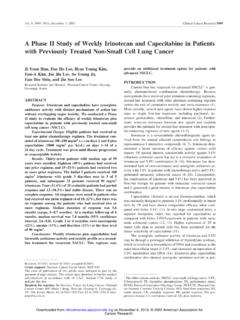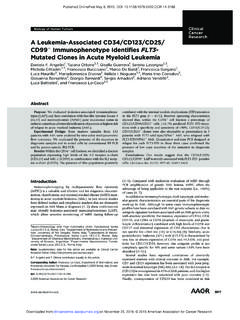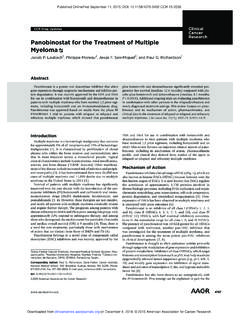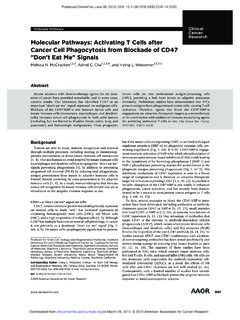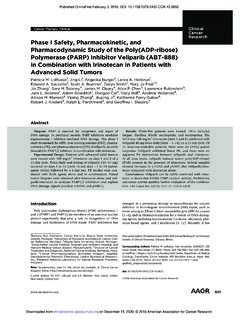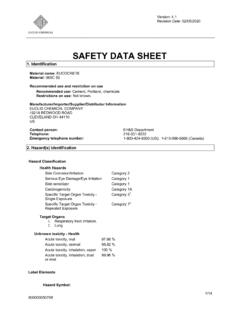Transcription of Strategies for Enzyme/Prodrug Cancer Therapy
1 3314 Vol. 7, 3314 3324, November 2001 Clinical Cancer Research Minireview Strategies for Enzyme/Prodrug Cancer Therapy1. Guang Xu and Howard L. McLeod2 expressed only at low concentrations in normal tissues (11, 12). Washington University School of Medicine, Departments of The protein must achieve sufficient expression in the tumors and Medicine, Molecular Biology & Pharmacology, and Genetics have high catalytic activity (13). The prodrug should be a good and the Siteman Cancer Center, St. Louis, Missouri 63110 substrate for the expressed enzyme in tumors but not be acti- vated by endogenous enzyme in nontumor tissues. It must be able to cross the tumor cell membrane for intracellular activa- Abstract tion, and the cytotoxicity differential between the prodrug and The selective activation of prodrug (s) in tumor tissues its corresponding active drug should be as high as possible. It is by exogenous enzyme(s) for Cancer Therapy can be accom- preferred that the activated drug be highly diffusible or be plished by several ways, including gene-directed enzyme actively taken up by adjacent nonexpressing Cancer cells for a prodrug Therapy (GDEPT), virus-directed enzyme prodrug bystander killing effect, the ability to kill any neighboring Therapy (VDEPT), and antibody-directed enzyme prodrug nonexpressing cells (13).
2 In addition, the half-life of active drug Therapy (ADEPT). The central part of Enzyme/Prodrug can- should be long enough to induce a bystander effect but short cer Therapy is to deliver drug-activating enzyme gene or enough to avoid the drug leaking out into the systemic circula- functional protein to tumor tissues, followed by systemic tion (13). administration of a prodrug . Although each approach Currently, delivery methods for an Enzyme/Prodrug strat- (GDEPT, VDEPT, and ADEPT) has been tested in clinical egy can be divided into two major classes: (a) delivery of genes trials, there are some potential problems using the current that encode prodrug -activating enzymes into tumor tissues delivery systems. In this article, disadvantages and advan- (GDEPT,3 VDEPT, etc.); and (b) delivery of active enzymes tages associated with each approach (GDEPT, VDEPT, and onto tumor tissues (ADEPT). An overview of these Strategies is ADEPT) and future perspective for improving current sys- shown in Fig.
3 1. The aim of this review is to summarize some tems are discussed. of the areas of recent progress in enzyme-activating prodrug Therapy and discuss areas of future development. Introduction Chemotherapy is an important treatment for Cancer pa- Approaches to Deliver Genes Encoding prodrug -activating tients. However, its success is limited by several drawbacks, enzymes into Tumor Cells including insufficient drug concentrations in tumors, systemic GDEPT. GDEPT, also known as suicide gene Therapy , is toxicity, lack of selectivity for tumor cells over normal cells, and a technique that involves physical delivery of a gene for a the appearance of drug-resistant tumor cells (1 7). A number of foreign enzyme to tumor cells where a systemically adminis- Strategies have been used to overcome these problems, including tered nontoxic prodrug can be activated after expression of the alternative formulations ( , liposomes; Ref. 8), resistance enzyme (5, 13 16).
4 Many GDEPT studies have used liposomal modulation ( , PSC833; Ref. 9), antidotes/toxicity modifiers gene delivery, but the challenge of vector delivery is common ( , ICRF-187; Ref. 10), and gene Therapy . One promising area for all areas of gene Therapy and has been exhaustively reviewed for improving tumor selectivity is enzyme prodrug Therapy . elsewhere (3, 11, 13). An early example of GDEPT is the Enzyme-activating prodrug Therapy is a two-step approach. combination of HSV-TK and GCV. GCV is an antiviral drug, In the first step, a drug-activating enzyme is targeted and ex- which is phosphorylated by HSV-TK and then by cellular ki- pressed in tumors. In the second step, a nontoxic prodrug , a nases to produce GCV triphosphate, which disrupts DNA syn- substrate of the exogenous enzyme that is now expressed in thesis during S phase, leading to cell death (1, 4, 16 20). A. tumors, is administered systemically (2 4). The net gain is that second early example is the combination of the bacterial CD and a systemically administered prodrug can be converted to high the antifungal drug 5-FC, which was effective to kill tumor cells local concentration of an active anticancer drug in tumors.
5 To be clinically successful, both enzymes and prodrugs should meet certain requirements for this strategy. The enzymes should be either of nonhuman origin or human protein that is absent or 3. The abbreviations used are: GDEPT, gene-directed enzyme prodrug Therapy ; ADEPT, antibody-directed enzyme prodrug Therapy ; CB1954, 5-(aziridin-1-yl)-2,4-dinitrobenzamide; CD, cytosine deaminase; CEA, carcinoembryonic antigen; CES, carboxylesterase; CMDA, 4-[(2-chlo- Received 5/22/01; accepted 7/3/01. roethyl)(2-mesyloxyethyl) amino] benzoyl-L-glutamic acid; CPA, car- The costs of publication of this article were defrayed in part by the boxypeptidase A; CPG2, carboxypeptidase G2; CPT-11, 7-ethyl-10- payment of page charges. This article must therefore be hereby marked [4-(1-piperidino)-1-piperidino] carbonyloxy-camptothecin (irinotecan);. advertisement in accordance with 18 Section 1734 solely to CYP, cytochrome P450 isozyme; 5-FC, 5-fluorocytosine; 5-FU, 5 - indicate this fact.
6 Fluorouracil; GCV, ganciclovir; GPAT, genetic prodrug activation ther- 1. Supported by the Siteman Cancer Center. apy; HSV, herpes simplex virus; IFA, ifosfamide; MTX, methotrexate;. 2. To whom requests for reprints should be addressed, at Washington NTR, nitroreductase; ODC, ornithine decarboxylase; RED, flavoen- University Medical School, Campus Box 8069, 660 South Euclid Av- zyme NADPH-p450 reductase; TK, thymidine kinase; TRE, tumor- enue, St. Louis, MO 63110. Phone: (314) 747-5186; Fax: (314) 747- specific transcriptional regulatory elements; VDEPT, virus-directed en- 2797; E-mail: zyme prodrug Therapy . Downloaded from on May 24, 2019. 2001 American Association for Cancer Research. Clinical Cancer Research 3315. Fig. 1 General outline of all approaches for Enzyme/Prodrug Cancer Therapy . Table 1 Selected examples of GDEPT. enzymes Prodrugs Model systems References Human -glucuronidase HMR 1826 Tumor cells and xenograft model in nude mice 2.
7 Bacterial nitroreductase CB1954 Chinese hamster and 3T3 cells 15, 23. Carboxypeptidase MTX- -peptide Cos-1 cells 4. CYP2B1 and p450 reductase Cyclophosphamide Rat 9L gliosarcoma cells 18. Rabbit CYP4B1 2-AA or 4-IMa Human, rat glioma cells and in nude mice tumor 12. model Thymidine phosphorylase 5-FU or 5 -DFURa LS 174T human colon carcinoma cells 1. Rabbit and human carboxylesterase Irinotecan Glioblastoma and rhabdomyosarcoma cells and 24. preclinical mouse xenograft model E. coli -galactosidase Anthracycline Human melanoma cells 25. Cytosine deaminase 5-FC Murine fibroblast cells 21. Thymidine kinase GCV Cisplatin-resistant human ovarian carcinoma cells 26. a 2-AA, aminoanthracene; 4-IM, 4-ipomennol; D FUR, 5 -deoxy-5-fluorouridine. after the conversion by CD to active 5-FU (20, 21). In a bystander effect of the NTR/CB1954 system, hydroxylamine addition to the above classical examples, many other enzyme/ metabolites of CB1954 were found to be able to cross cell prodrug combinations have been used for GDEPT (Table 1; membranes freely and are responsible for a bystander effect, Refs.)
8 13 and 22). independent of gap junctions (23). Although the cell-permeable Many of the Enzyme/Prodrug systems applied in GDEPT, active metabolites of prodrugs for GDEPT have advantages in including HSV-TK/GCV, Escherichia coli CD/5-FC, and E. certain situations, such as tumors with few gap junctions, the coli NTR/CB1954, act intracellularly by converting prodrugs downside of this mode is the cytotoxicity to adjacent normal into active drugs within cells (2). This mode of action requires tissues and the risk of systemic diffusion (23). cell-cell contact to mediate maximal killing. Recently, an extra- GDEPT can also be used to improve the selectivity of cellular cytotoxic effector system was reported in which a currently used agents. CYP-based prodrug activation systems is secreted form of lysosomal human -glucuronidase, which con- one example that shows promise for clinical use (27). Members verts an inactive glucuronidated derivative of doxorubicin of the CYP enzyme superfamily convert the chemotherapeutic (HMR 1826) to the cytotoxic doxorubicin, was introduced into agents cyclophosphamide and IFA to active alkylating agents tumor cells (2).
9 There was evidence that a bystander effect that cause cell death (27). The expression of CYP is generally resulted in a significant tumor cell killing both in vitro and in a high in liver but lower in tumor cells (27), providing a potential human xenograft model in nude mice (2). The advantage of this mechanism for intrinsic drug resistance. Tumor cells are highly extracellular system is that a hydrophilic prodrug was converted sensitive to cyclophosphamide or IFA after the delivery of the into a lipophilic, cell-permeable cytotoxic drug outside cells so CYP2B1 gene into tumor cells both in vitro and in vivo (28). To that both transduced and nontransduced cells were targeted. As additionally improve and increase the efficiency of this system, cell-cell contact is not required for a bystander effect, the killing a two enzymes /one prodrug system was developed. In this ability of this system is enhanced. To explore the mechanism of study, CYP2B1 was coexpressed with the RED gene and used to Downloaded from on May 24, 2019.
10 2001 American Association for Cancer Research. 3316 Enzyme/Prodrug Cancer Therapy Table 2 Selected examples of VDEPT. Viral vectors enzymes delivered Prodrugs Model system References Adenovirus Herpes simplex virus thymidine kinase GCV Mouse prostate Cancer cell line and clinical trials 19, 37, 38. Human carboxylesterase Irinotecan Human lung adenocarcinoma cell lines and nude 39. mice tumor model E. coli nitroreductase CB1954 Ovarian tumor cells and animal model of 40, 41. disseminated intraperitoneal carcinoma Retrovirus E. coli nitroreductase CB1954 Colorectal, pancreatic, ovarian Cancer cells and 20, 30, 41. xenografts of human ovarian & pancreatic Cancer Yeast cytosine deaminase 5-FC SCC VII murine squamous carcinoma cells and 42. YCD-expressing tumors Human CYP and p450 reductase Cyclophosphamide Gliosarcoma cells and in vivo tumor model 43. and IFA. EBV Nitroreductase CB1954 EBV-positive B-cell lines 35. activate prodrug cyclophosphamide in tumor cells (18).
